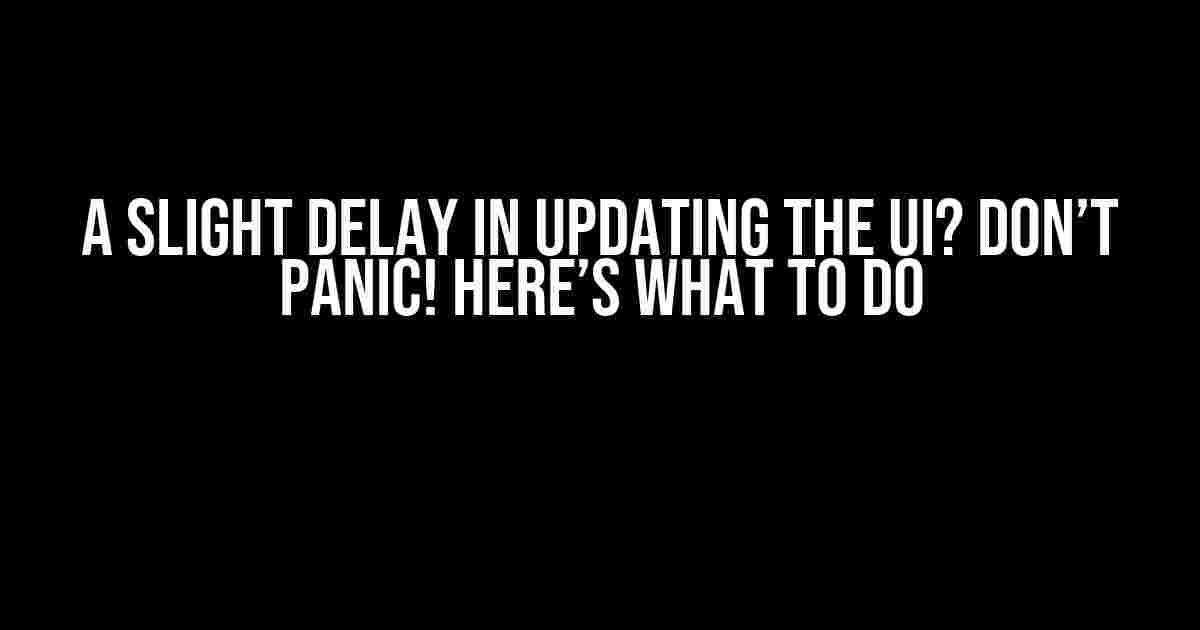Have you ever encountered a situation where your UI doesn’t update as expected? You make changes to your code, but the changes don’t reflect in the UI. You’re left scratching your head, wondering what went wrong. Fear not, dear developer! A slight delay in updating the UI is a common issue that can be resolved with ease. In this article, we’ll dive into the possible causes and solutions to this problem.
What Causes a Slight Delay in Updating the UI?
Before we dive into the solutions, let’s first understand the possible reasons behind this issue. A slight delay in updating the UI can occur due to various reasons, including:
- Asynchronous Operations: When your code performs asynchronous operations, it can take some time for the UI to update. This is because the updating process runs in the background, and the UI might not reflect the changes immediately.
- Background Tasks: If your app is performing tasks in the background, it can cause a delay in updating the UI. This is especially true if the background tasks are resource-intensive.
- Resource Constraints: When your app is running low on system resources, such as memory or CPU, it can slow down the updating process.
- Layout and Rendering Issues: Issues with layout and rendering can cause a delay in updating the UI. This can be due to complex layouts, inefficient rendering, or incorrect use of UI components.
Solutions to a Slight Delay in Updating the UI
Now that we’ve identified the possible causes, let’s explore the solutions to this problem. Here are some steps you can take to resolve the issue:
1. Optimize Asynchronous Operations
When performing asynchronous operations, use callbacks or promises to ensure that the UI updates correctly. You can also use async/await syntax to make your code more readable and efficient.
async function updateUI() {
try {
const data = await fetchData();
updateUIThread(data);
} catch (error) {
console.error(error);
}
}
function updateUIThread(data) {
// Update the UI using the received data
}
2. Prioritize Background Tasks
Prioritize your background tasks to ensure that they don’t interfere with the UI updating process. Use scheduling algorithms to optimize task execution and reduce resource contention.
const taskQueue = [];
function scheduleTask(task) {
taskQueue.push(task);
setTimeout(() => {
task();
}, 0);
}
scheduleTask(() => {
// Perform background task
});
3. Optimize Resource Usage
Optimize resource usage by reducing memory leaks, using efficient algorithms, and leveraging system resources effectively. Use profiling tools to identify performance bottlenecks and optimize accordingly.
function optimizeResourceUsage() {
// Use efficient algorithms
const sortedArray = Array.from(data).sort((a, b) => a - b);
// Reduce memory leaks
data = null;
}
4. Resolve Layout and Rendering Issues
Resolve layout and rendering issues by optimizing your UI component tree, reducing layout passes, and using efficient rendering techniques.
function optimizeLayout() {
// Optimize UI component tree
const optimizedTree = optimizeComponentTree(componentTree);
// Reduce layout passes
component.setLayoutParams(optimizeLayoutParams());
}
function optimizeRendering() {
// Use efficient rendering techniques
canvas.render usingHardwareAcceleration = true;
}
Best Practices to Avoid a Slight Delay in Updating the UI
To avoid a slight delay in updating the UI, follow these best practices:
- Use Efficient Data Structures: Use efficient data structures to reduce memory allocation and deallocation. This can help improve performance and reduce the likelihood of UI delays.
- Avoid Over-Engineering: Avoid over-engineering your code by using unnecessary complexity. Keep your code simple, readable, and maintainable.
- Profile and Optimize: Profile your code regularly to identify performance bottlenecks. Optimize your code accordingly to improve performance and reduce delays.
- Test Thoroughly: Test your code thoroughly to identify and fix issues early on. This can help reduce the likelihood of UI delays and other performance issues.
- Keep Your Code Up-to-Date: Keep your code up-to-date with the latest best practices and technologies. This can help improve performance, reduce delays, and ensure compatibility with the latest systems.
Conclusion
A slight delay in updating the UI can be frustrating, but it’s a common issue that can be resolved with ease. By understanding the possible causes and implementing the solutions outlined in this article, you can ensure that your UI updates correctly and efficiently. Remember to follow best practices, optimize resource usage, and test thoroughly to avoid delays and improve overall performance.
| Cause | Solution |
|---|---|
| Asynchronous Operations | Optimize asynchronous operations using callbacks, promises, or async/await syntax |
| Background Tasks | Prioritize background tasks using scheduling algorithms |
| Resource Constraints | Optimize resource usage by reducing memory leaks, using efficient algorithms, and leveraging system resources effectively |
| Layout and Rendering Issues | Resolve layout and rendering issues by optimizing the UI component tree, reducing layout passes, and using efficient rendering techniques |
By following these guidelines, you can ensure that your UI updates correctly and efficiently, providing a seamless user experience.
Remember, a slight delay in updating the UI is not the end of the world. With the right approach and techniques, you can resolve the issue and provide a faster, more responsive UI that delights your users.
Here are 5 Questions and Answers about “Slight delay in updating the UI” in a creative voice and tone, using HTML:
Frequently Asked Questions
Having trouble with a slight delay in updating the UI? Don’t worry, we’ve got you covered! Check out our FAQs below to get the scoop.
What could be causing the delay in updating the UI?
There could be several reasons for the delay, including high server load, network connectivity issues, or even a minor bug in the system. Don’t worry, our dev team is always on the lookout for tweaks to optimize performance!
How long does the delay usually last?
In most cases, the delay is temporary and resolves itself within a few seconds. If you’re experiencing a longer delay, try refreshing the page or checking your internet connection.
What can I do to minimize the delay?
To minimize the delay, make sure you’re running the latest version of our app or software, and that your device meets the minimum system requirements. You can also try closing other resource-intensive apps or background processes.
Will the delay affect my data or progress?
No way! The delay is purely cosmetic, so it won’t affect your data, progress, or any of your hard-earned achievements. You can rest easy knowing your stuff is safe!
How do I report the delay if it persists?
If the delay persists, please don’t hesitate to reach out to our support team! We’re here to help and would love to troubleshoot the issue with you. Just click that “Help” button and let us know what’s going on.
Let me know if you’d like me to make any changes!


